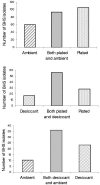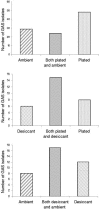Recovering streptococci from the throat, a practical alternative to direct plating in remote tropical communities
- PMID: 16455911
- PMCID: PMC1392699
- DOI: 10.1128/JCM.44.2.547-552.2006
Recovering streptococci from the throat, a practical alternative to direct plating in remote tropical communities
Abstract
Throat swabs are regarded as the "gold standard" for diagnosing streptococcal pharyngitis and for surveillance research. Culturing throats in remote tropical settings is logistically difficult, and these settings are commonly burdened by high rates of streptococcal disease. The survival of streptococci on swabs may depend on whether they are of "throat" or "skin" type, as determined by emm pattern typing. The aims of this study were to compare the recovery rates of beta-hemolytic streptococci (BHS) using three different transport methods and to determine whether the recovery rates correlated with the emm pattern type. Monthly duplicate throat swabs were taken from occupants of selected households in three remote Aboriginal communities. Paired swabs were separated and handled in one of three ways: (i) direct inoculation onto culture media with cold-box transport (plated), (ii) sealed in a bag with a silica gel desiccant and cold-box transport (desiccant), and (iii) transport at ambient temperature and humidity (ambient). emm pattern typing was done by standard methods. Over 23 months, 4,842 throat swabs were taken, and 4,122 were paired. BHS were recovered on 11.5% of the 4,842 occasions (group A, 4.5%; group C, 1.7%; group G, 5.4%). Results from paired swabs showed the plated method was superior to desiccant and desiccant was better than ambient. Pooled data indicated that plated and desiccant were equivalent, and both were significantly better than ambient. There was no correlation between the emm pattern type and recovery of group A streptococci by different methods. In tropical and remote settings, cold-box transport with desiccant and subsequent inoculation of culture plates in the laboratory is a practical alternative to direct plating.
Figures




Similar articles
-
Low rates of streptococcal pharyngitis and high rates of pyoderma in Australian aboriginal communities where acute rheumatic fever is hyperendemic.Clin Infect Dis. 2006 Sep 15;43(6):683-9. doi: 10.1086/506938. Epub 2006 Aug 9. Clin Infect Dis. 2006. PMID: 16912939
-
Advantages of blood agar-NaCl selective medium in the isolation of beta-hemolytic streptococci from throat swabs.Adv Exp Med Biol. 1997;418:41-3. doi: 10.1007/978-1-4899-1825-3_10. Adv Exp Med Biol. 1997. PMID: 9331594 No abstract available.
-
Prospective surveillance of streptococcal sore throat in a tropical country.Pediatr Infect Dis J. 2009 Jun;28(6):477-82. doi: 10.1097/INF.0b013e318194b2af. Pediatr Infect Dis J. 2009. PMID: 19483515
-
Asymptomatic pharyngeal carriage of beta-haemolytic streptococci and streptococcal pharyngitis among patients at an urban hospital in Croatia.Eur J Epidemiol. 1993 Jul;9(4):405-10. doi: 10.1007/BF00157398. Eur J Epidemiol. 1993. PMID: 8243596 Review.
-
Suitability of throat culture procedures for detection of group A streptococci and as reference standards for evaluation of streptococcal antigen detection kits.J Clin Microbiol. 1990 Feb;28(2):165-9. doi: 10.1128/jcm.28.2.165-169.1990. J Clin Microbiol. 1990. PMID: 2179252 Free PMC article. Review. No abstract available.
Cited by
-
Use of a single-nucleotide polymorphism genotyping system to demonstrate the unique epidemiology of methicillin-resistant Staphylococcus aureus in remote aboriginal communities.J Clin Microbiol. 2006 Oct;44(10):3720-7. doi: 10.1128/JCM.00836-06. J Clin Microbiol. 2006. PMID: 17021102 Free PMC article.
-
Prevalence, Clinical Features and Antibiotic Susceptibility of Group A Streptococcal Skin Infections in School Children in Urban Western and Northern Uganda.Pediatr Infect Dis J. 2019 Dec;38(12):1183-1188. doi: 10.1097/INF.0000000000002467. Pediatr Infect Dis J. 2019. PMID: 31568247 Free PMC article.
-
emm and C-repeat region molecular typing of beta-hemolytic Streptococci in a tropical country: implications for vaccine development.J Clin Microbiol. 2009 Aug;47(8):2502-9. doi: 10.1128/JCM.00312-09. Epub 2009 Jun 10. J Clin Microbiol. 2009. PMID: 19515838 Free PMC article.
-
Epidemiology of Streptococcus dysgalactiae subsp. equisimilis in tropical communities, Northern Australia.Emerg Infect Dis. 2007 Nov;13(11):1694-700. doi: 10.3201/eid1311.061258. Emerg Infect Dis. 2007. PMID: 18217553 Free PMC article.
-
Prevalence, Antibiotic Susceptibility Profile and Associated Factors of Group A Streptococcal pharyngitis Among Pediatric Patients with Acute Pharyngitis in Gondar, Northwest Ethiopia.Infect Drug Resist. 2023 Mar 22;16:1637-1648. doi: 10.2147/IDR.S402292. eCollection 2023. Infect Drug Resist. 2023. PMID: 36992964 Free PMC article.
References
-
- Bessen, D., C. Sotir, T. Readdy, and S. Hollingshead. 1996. Genetic correlates of throat and skin isolates of group A streptococci. J. Infect. Dis. 173:896-900. - PubMed
-
- Bessen, D. E., J. R. Carapetis, B. Beall, R. Katz, M. Hibble, B. J. Currie, T. Collingridge, M. W. Izzo, D. A. Scaramuzzino, and K. S. Sriprakash. 2000. Contrasting molecular epidemiology of group A streptococci causing tropical and nontropical infections of the skin and throat. J. Infect. Dis. 182:1109-1116. - PubMed
-
- Carapetis, J., C. Connors, D. Yarmirr, V. Krause, and B. Currie. 1997. Success of a scabies control program in an Australian Aboriginal community. Pediatr. Infect. Dis. J. 16:494-499. - PubMed
Publication types
MeSH terms
Substances
LinkOut - more resources
Full Text Sources
Medical

